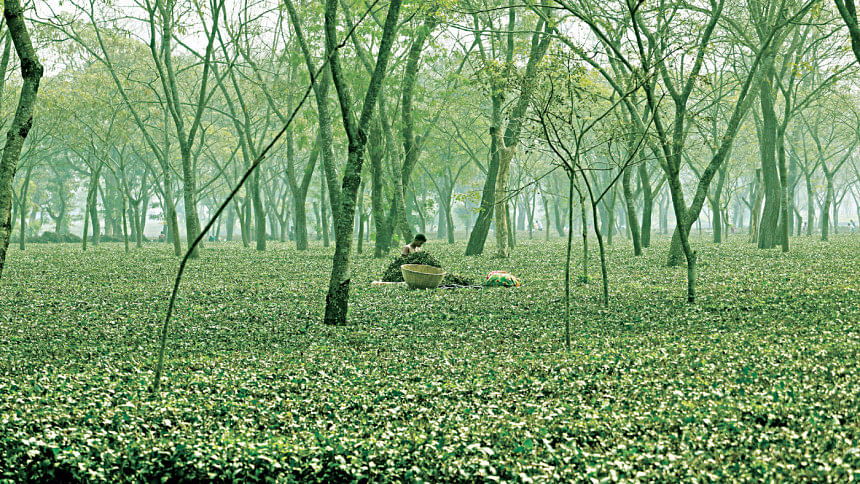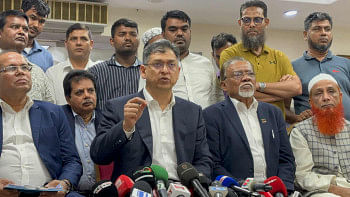Tea production, acreage rising in northern districts

Tea production in Panchagarh and other northern districts grew considerably benefitting thousands of farmers although the ongoing coronavirus pandemic affected many other sectors of the economy.
Tea cultivation in the flatlands of Panchagarh began in the late 1990s due to its favourable weather and soil but soon expanded to other districts in the region.
At least 10.30 million kilogrammes (kgs) of tea worth Tk 175 crore was produced in the area last year, according to data from the Bangladesh Tea Board's regional office in Panchagarh.
In 2020, production increased by 7.11 lakh kgs compared to the year before, officials said.
Besides, tea was cultivated on around 10,170 acres of land last year, a roughly 15 per cent increase compared to 2019.
The country's overall tea production for 2020 was 86.39 million kgs, of which nearly 12 per cent was produced on flatlands in 5 districts of the northern belt --Dinajpur, Thakurgaon, Panchagarh, Nilphamari, and Lalmonirhat.
According to the officials, 7,337 large and small scale tea gardens collectively produced 51.28 million kgs of tea leaves last year. There are eighteen tea processing factories spread across Thakurgaon and Panchagarh.
The tea grown in Panchagarh is also exported to many countries.
Since the district lies in the northernmost region of the country and shares a border with India, it was largely considered a backwater. However, tea cultivation brought a massive change over the years by creating many job opportunities for locals.
Many farmers left paddy and other traditional crop farming to begin tea cultivation as they felt it to be profitable.
There are currently 6,523 large and small scale tea growers involved with the sector across various upazilas of Panchagarh that produce exportable tea on 8,642 acres of land.
There are 1,007 registered tea farmers in Panchagarh, where 10 large scale tea states account for a lion's share of the area's total production.
In Thakurgaon, 659 small scale farmers have been producing tea leaves on 1,293 acres of land for the last couple of years. More than 95 farmers cultivated tea on 112.98 acres of land in Lalmonirhat, while 32 farmers grew tea on 61.09 acres in Nilphamari and 26 farmers produced tea on 61.50 acres in Dinajpur.
Nazrul Islam, a farmer of Polashbari union in Birganj upazila of Dinajpur, once grew paddy on his land but as he incurred losses for several years, he decided to switch to tea gardening.
He planted tea saplings on his one-acre land in 2015 and started harvesting the leaves 3 years later.
"I earned Tk 3 lakh in 2020 by selling 10,500 kgs of tea leaves," said Islam.
"Tea leaf farming is a profitable business now," he added.
Nazrul went on to say that many farmers of his village started tea cultivation after witnessing his success.
Suja Ur Rob Chowdhury, president of the Dinajpur Chamber of Commerce and Industry and owner of Sallylun Tea States in Panchagarh, said that success came to the tea sector this year as farmers had given their best amid the Covid-19 outbreak.
The large area of Panchagarh remained uncultivated back in the late 1990s but then tea farming changed the district's economy, Chowdhury said.
It also created employment for a large number of people in the district, especially women.
Chowdhury urged the government to extend its support for the growing tea sector in Panchagarh to give it more access to international markets.
Dr Mohammad Shamim Al Mamun, director of the Northern Bangladesh Project of the Bangladesh Tea Board and also a senior scientific officer in Panchagarh, said tea production and the amount of land used for it increased last year compared to 2019 as the farmers got better profits.
"We tried our best to provide the highest support to farmers after Covid-19 hit the country in March last year," Mamun added.

 For all latest news, follow The Daily Star's Google News channel.
For all latest news, follow The Daily Star's Google News channel. 



Comments